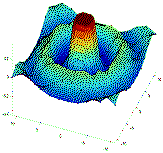

Numerical Methods
for Calculus & DE
 |
MA3457/CS4033 Project # 1: Interpolation |
|---|
 Sections B01/B01
Sections B01/B01
 Mon, Tue, Thu, Fri - 2:00 pm
Mon, Tue, Thu, Fri - 2:00 pm| Basics |
|---|
This project consists of two parts. The first one contains two practical problems from environmental (water-resources) engineering formulated below. For the second part, you are expected to identify, formulate, and solve an applied problem from the area of your concentration/major.
When solving all three problems, rely on your knowledge of interpolation and demonstrate the use of both Newton and Lagrange interpolating polynomials and corresponding MATLAB procedures. Compare the results; make a conclusion. Include essential and new elements of the MATLAB scripts and MATLAB outputs in your report along with concise but comprehensive comments on your solution.
| Part 1 |
|---|
Problem 1
Background and Data: In Spring 1999, the concentration of total phosphrous (p in mg/m^3) and chlorophyll a (c in mg/m^3) for each of the Great Lakes was measured and found to be:|
Lake Superior Lake Michigan Lake Huron Lake Erie: * West basin * Central basin * East basin Lake Ontario |
p 4.5 8.0 5.5 39.0 19.5 17.5 21.0 |
c 0.8 2.0 1.2 11.0 4.4 3.8 5.5 |
|---|
The concentration of chlorophyll a indicates how much plant life is suspended in the water. As such, it indicates how unclear and unsightly the water appears.
Question: In Summer 1999, waste treatment was performed to lower the phosphorous concentration of western Lake Erie; the goal was set to reach 15 mg/m^3. Estimate the level of chlorophyll corresponding to this concentration.
Problem 2
Background: Lakes in temperate zones can become thermally stratified during the summer. Warm, buoyant water near the surface overlies colder, denser water. Such stratification effectively divides the lake vertically into two layers: the epilimnion and the hypolimnion separated by a plane called the thermocline.
Thermal stratification has great significance for environmental engineers studying the pollution of such systems. In particular, the thermocline greatly diminishes mixing between the two layers. As a result, decomposition of organic matter can lead to severe depletion of oxygen in the isolated bottom waters.
Data and Question: Measurement conducted on some summer day for Platte Lake, MI showed the following dependence of temperature on depth:
T,C 22.8 22.8 22.8 20.6 13.9 11.7 11.1 11.1Find the depth of the thermocline.
Hint: The location of the thermocline can be defined as the inflection point of the temperature-depth curve.
| Part 2: |
|---|
Problem from Your Field
Background, Data, Question
Course Information | Homework Assignments | Mini Projects | Test Preview | Announcements & Hints